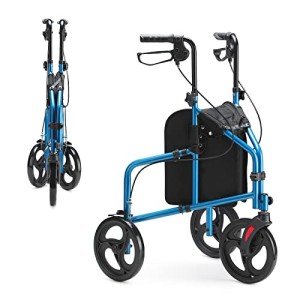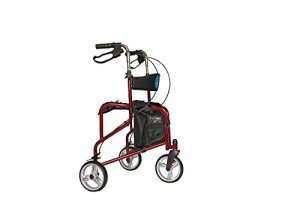
How To Use A Rollator
FollowOverview
-
Founded Date August 21, 1946
-
Sectors Energy & Utilities
Company Description
The 10 Scariest Things About Medical Walker

Understanding Medical Walkers: A Comprehensive Guide
Medical walkers work as important mobility aids for individuals recuperating from surgery, handling chronic diseases, or dealing with age-related mobility problems. These devices not just boost physical self-reliance but also improve safety, enabling users to navigate their environments with greater ease. This short article explores the types, benefits, functions, and considerations connected with medical walkers, together with some frequently asked concerns.
Tabulation
- Kinds Of Medical Walkers
- Benefits of Using a Medical Walker
- Secret Features to Consider
- Often Asked Questions
- Conclusion
1. Kinds Of Medical Walkers
Medical walkers are readily available in different designs, dealing with different needs and choices. The primary types consist of:
| Type of Walker | Description |
|---|---|
| Standard Walker | A rectangle-shaped frame with 4 legs, using stability and assistance. |
| Two-Wheeled Walker | Comparable to a basic walker however equipped with wheels at the front for much easier motion. |
| Three-Wheeled Walker | A lightweight walker with three wheels, enabling more maneuverability, perfect for indoor use. |
| Rollator Walker | A walker with 4 wheels, hand brakes, and a seat, suitable for longer distances and resting requirements. |
| Hemi Walker | Developed for people who can use only one hand, featuring a tripod-like design. |
2. Benefits of Using a Medical Walker
Using a medical walker provides several benefits that add to the user’s overall well-being, including:
- Increased Stability: Walkers supply a steady base of assistance, minimizing the danger of falls.
- Enhanced Mobility: They allow users to move around more quickly, promoting independence.
- Discomfort Relief: By rearranging weight, walkers can reduce discomfort in the joints, especially in the hips and knees.
- Posture Support: These gadgets motivate appropriate posture, lowering strain on the back.
- Improved Confidence: Users frequently feel more safe and secure utilizing walkers, leading to much better self-esteem and increased activity levels.
3. Secret Features to Consider
When selecting a medical walker, it’s crucial to examine different functions to discover the ideal fit. Here are some important aspects to consider:
- Weight Capacity: Ensure the walker can support the user’s weight while maintaining stability.
- Height Adjustment: Look for a walker with adjustable height settings to accommodate the user’s height and supply comfy grip.
- Product: Lightweight aluminum walkers are easier to navigate, while steel walkers use stronger support but may be heavier.
- Wheel Quality: If deciding for a wheeled walker, think about the wheel size and tread. Bigger wheels navigate irregular surfaces more easily.
- Seat Availability: If users will be walking for longer durations, a walker with an integrated seat can supply rest breaks when needed.
- Brakes: Hand brakes are specifically essential for safety in rollator walkers to manage speed and stop when needed.
Kinds of Walkers with Features Comparison Table
| Walker Type | Weight Capacity | Height Adjustment | Wheels | Seat Available | Brakes |
|---|---|---|---|---|---|
| Requirement Walker | As much as 300 pounds | Yes | No | No | No |
| Two-Wheeled Walker | As much as 300 lbs | Yes | Yes | No | No |
| Three-Wheeled Walker | As much as 250 pounds | Yes | Yes | No | No |
| Rollator Walker | Up to 400 pounds | Yes | Yes | Yes | Yes |
| Hemi Walker | Approximately 250 lbs | Yes | No | No | No |
4. Regularly Asked Questions
Q1: Who should use a medical walker?A: Medical walkers are beneficial for people recuperating from surgical treatment, experiencing balance problems, or requiring help due to age-related mobility challenges. Q2: Can a medical walker be adjusted?A: Yes, many
medical walkers are height-adjustable to accommodate various user heights, permitting a more comfortable grip. Q3: How do I choose the right walker for my needs?A: Consider aspects such as the
user’s weight, height, type of mobility issues, and whether they need a seat or brakes. Evaluating the walker for convenience and stability before purchase is also advisable. Q4: Are there any safety pointers associated with utilizing a medical walker?A: Yes, users need to ensure they don’t lean too
greatly on the walker, use it on stable and level surface areas, and constantly ensure
the brakes are engaged when seated or stationary. Q5: Can walking with a medical walker assist with rehabilitation?A: Absolutely. Medical walkers are often suggested as part of rehab programs as they motivate
exercise, which aids in recovery and mobility enhancement. 5.
Conclusion Medical walkers play a vital role in improving the lifestyle for individuals dealing with mobility challenges. With numerous types and features available, selecting the ideal walker involves thinking about the user’s specific needs and circumstances. By comprehending their benefits and correct use, individuals can restore independence, improve their mobility, and navigate their environments safely. Whether for short-term healing or long-lasting assistance, the ideal medical walker can significantly boost a user’s overall well-being. Integrating a medical walker into one’s day-to-day regimen can be a transformative choice, making it easier to get involved in life’s everyday activities while making sure safety and self-confidence.
